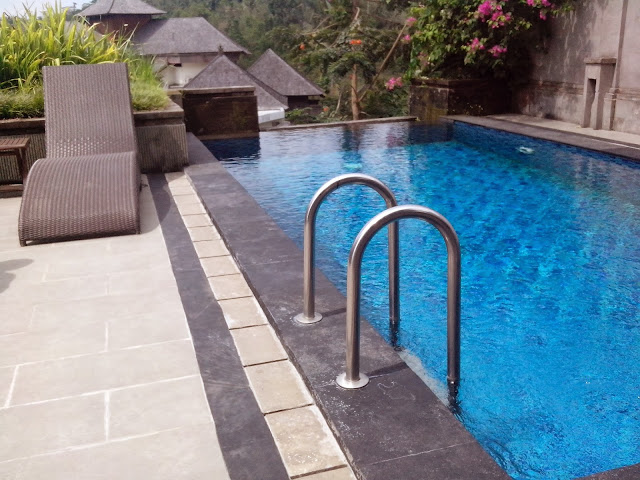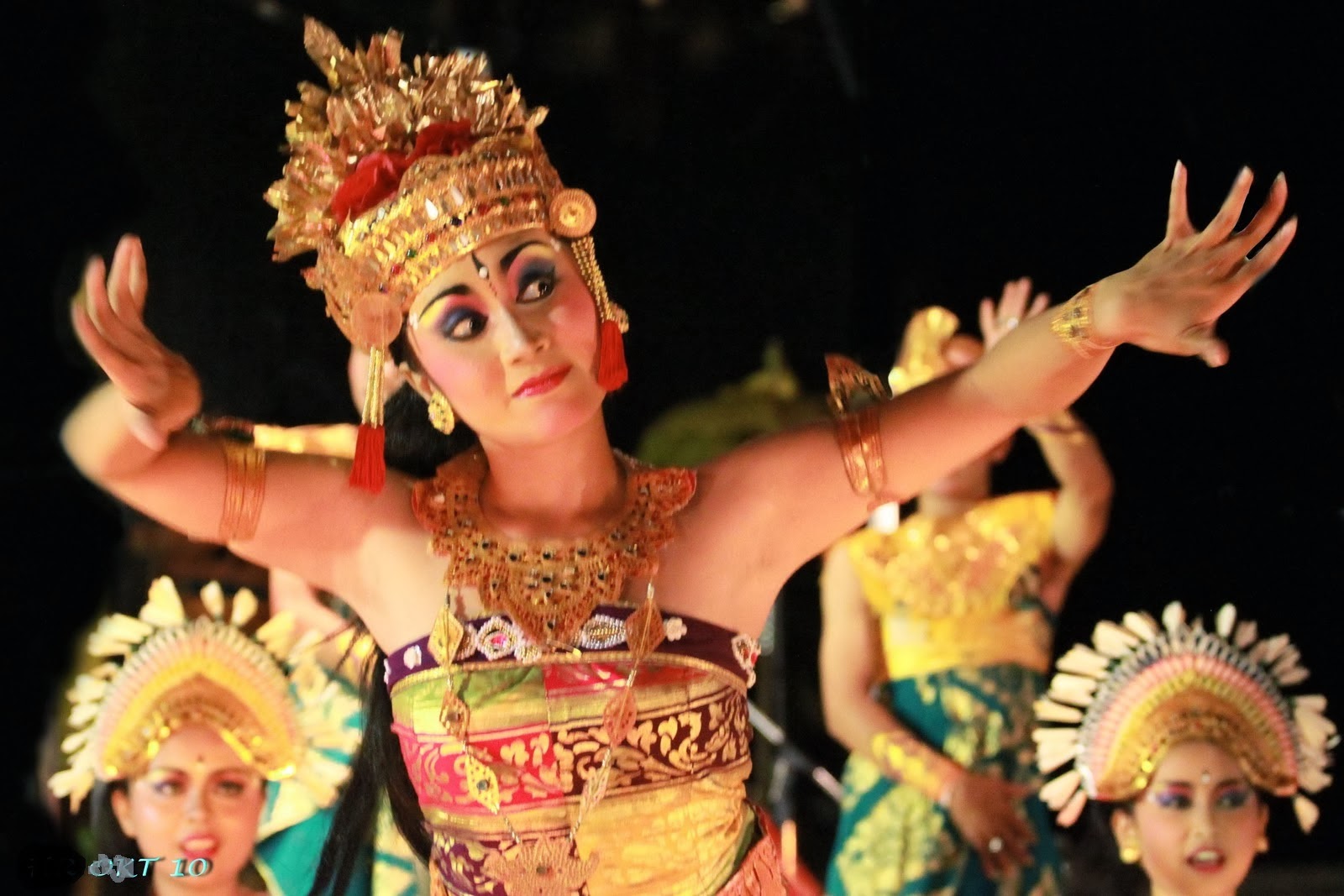An early center of Hinduism on Bali, the country town of Tampaksiring is located just 14 kilometers northeast of Ubud and one kilometer south of the sacred bathing place Tirta Empul. A number of important religious sites – Pura Gunung Kawi Sebatu, Pura Sakenan, Gunung Kawi - are found in this mountainous area near the life-giving source of the Pakrisan River northern Gianyar Regency.
Built under the rule of Sri Candrabhaya Singha Warmadewa in the 10th century, the Tirta Empul temple complex was completely restored in 1969. Most people include Tampaksiring in a day trip out of Ubud, taking in the monumental Gunung Kawi two kilometers downstream on the same outing.
The impressive buildings, pools and fountains of Tirta Empul are on nearly every tour group’s itinerary of central Bali. On busy days fleets of tour buses visit the site, which is open only during daylight hours. From the parking lot, the visitor walks unimpeded into the majestic outer courtyard under a spectacular banyan tree, then climbs through the main gateway into the temple compound proper.
While visitors are spoiled for choice of temples in Bali, Tirta Empul’s atmosphere is quite distinct from your usual run of temples and holy sites on Bali. We immediately savored the serenity of the place set against a backdrop of hillside lawns and surviving forest. Though crowded with perhaps as many as 200 visitors, it was still a pleasure to walk around.
Seeking protective blessings and deliverance from illness, people journey from all over Bali to bathe in these sacred cleansing springs where worshippers pray in two divided pools as water gushes out of a row of stone spouts. The buildings, the 20 small sugar-palm thatched shrines and the elaborate carvings adorning the lichen-covered walls surrounding the pools are beautifully decorated and well maintained. Seeing it on a rainy day adds even more mystery to the site.
Looming over the complex, across a whole hilltop to the north, is the opulent Tampaksiring Palace built by Sukarno, the first president of Indonesia, during the early years of the republic. No hawkers are allowed into the temple area, but when exiting we had to run a gauntlet of souvenir sellers that wind maze-like back to the parking lot. On this morning the stalls were quiet and many were closed, so the market made for half an hour leisurely shopping.
Layout
Tirta Empul conforms to the basic structure of most Balinese temples, divided into three main courtyards: the front, middle and inner sanctum. The first courtyard with a souvenir shop and two cafes is almost completely taken up by a giant koi pond with enormous well-tended gold, white and speckled fish swimming blithely about.
On the right as we entered the second courtyard, a short flight of steps led to two rectangular bathing pools, one for men and one for women. Ladies wore all of their clothing while the men wore just their t-shirts. According to tradition, the waters from the pool’s 15 figurative spouts are believed to offer a wide spectrum of curative properties, cleansing from evil and spiritual purification.
A pregnant lady and a newly married Balinese couple in traditional attire were among those seeking the water’s blessings. Widely thought to possess magical powers, the water is also used as an antidote for poison and black magic. The legend goes that the spring was created by the god Indra, who pierced the Earth to tap amerta, the restoring waters that brought life back to his army, which had been poisoned by the demon-king Mayadanava, the chief architect of the netherworld.
The Balinese use holy water as an essential part of almost every ritual. Their Bali Hindu religion is in fact called Agama Tirta, or “The Religion of the Holy Water.” Tirta Empul’s water is looked upon as the holiest on Bali. People were collecting the water in bottles to take home. Regular ceremonies are held at this sanctuary, particularly during Galungan, when dance clubs from the surrounding area bring their sacred barong masks to be purified.
The gin-clear natural spring at a higher level is the source of the water that shoots out of the spouts. The water, which bubbles up at the bottom of a large pool, is so transparent that the black sand and layers of flora growing on the bottom clearly visible, as are a number of fish and eels. Because it’s believed that the spring possesses the elixir of immortality, it’s surrounded by a high wall to prevent it from being profaned.
Tirta Empul Temple was built in 926 A.D. during the Warmadewa Dynasty (10th to 14th centuries) on the site of a large freshwater spring. In ancient Bali places for bathing and fetching water were very common, and elaborate fountains and bathing places such as Tirta Empul have long been considered sacred and the object of pilgrimages.
An inscription in Old Balinese found in Pura Sakenan in the village of Manukaya, north of Tirta Empul, states that two ponds were formed here in A.D. 962. When the badly worn inscription was finally deciphered by Sutterheim in 1969, it described in detail the ritual cleansing of a holy stone during the full moon of the fourth month in the Balinese calendar. For more than 1,000 years villagers from Manukaya carried the stone to the spring for purification rites on the precise day each year of Tirta Empul’s founding, never knowing the origin or the reason, only that it was customary law (adat). The fact that the stone was so badly worn lends credence to the fact that this bathing ritual took place. Since none of the villagers then knew what the old inscription read, the date of the temple’s founding must have been handed down orally through 33 generations of invasions, dynastic changes and natural disasters.
Istana Tampaksiring
North of Tampaksiring, a road branches to the right for Tirta Empul while the main continues climbing straight ahead to the hilltop retreat built by President Sukarno in 1954. Officially known as Istana Kepresidenan Tampaksiring Bali, we turned in at the sign before the entrance and immediately faced a formidable vehicle security barrier. At the guard post to enter this still-functioning government facility, we were told we had to send a request letter to the Department of Education (Departemen Pendidikan Nasional) in Yogyakarta. After taking down the address details, I had to content myself with roaming the huge parking lot, trying to get a glimpse of the interior over a high wall.
I had visited this splendid presidential palace in the 1980s, mingling among a horde of Japanese who have always been fascinated by Sukarno’s life and the memorabilia he left behind. With its large, well-kept lawns, its two main areas connected by a footbridge, the istana is a classic example of the first truly Indonesian national architectural style. The sprawling, one-story buildings feature grooved plaster columns and the geometrically hard lined look of the art deco era. Sukarno is said to have designed the whole complex himself, a sort of architectural amalgam of ranch-house, Javanese pendopo and social realism that he had picked up during his engineering training at ITB in Bandung.
Sukarno was half Balinese and he visited the island frequently, usually staying in this government rest house. The palace purposefully and rather incongruously overlooks Tirta Empul, known as the Balinese Fountain of Eternal Youth, as if it were the dictator’s intention to prolong his “President-for-Life” status indefinitely. Although it serves as a conference site, few overnight guests stay at the palace where it is said Sukarno’s ghost still roams.
On the palace grounds are four complexes: Wisma Merdeka, the personal residence of the president; Wisma Negara for friends or guests of state; Wisma Yudistira for use by the press corps; and Wisma Bima for the presidential bodyguard. There’s a lovely pendopo for dance performances and a small aviary, which once held hornbills, eagles and peacocks. Completely restored in 1957 and superbly maintained ever since, all buildings are in mint condition with some of the original furnishings intact.
The palace provides an excellent view of the whole Tirta Empul sanctuary. The story goes that the president, renown for his womanizing, could look down through a telescope upon the naked women bathing below. For years it was rumored that Sukarno’s daughter owned one of the warung in the temple’s souvenir market.
The Soviet Premier Khrushchev once watched a legong dance on these palace grounds at a time (1965) when Sukarno’s government had incurred debts of US$2.5 billion, half on loans for purchases of military equipment from Russia. After Sukarno was toppled in 1967, the palace became once again a government rest house and museum, open only to the public by formal application.


















